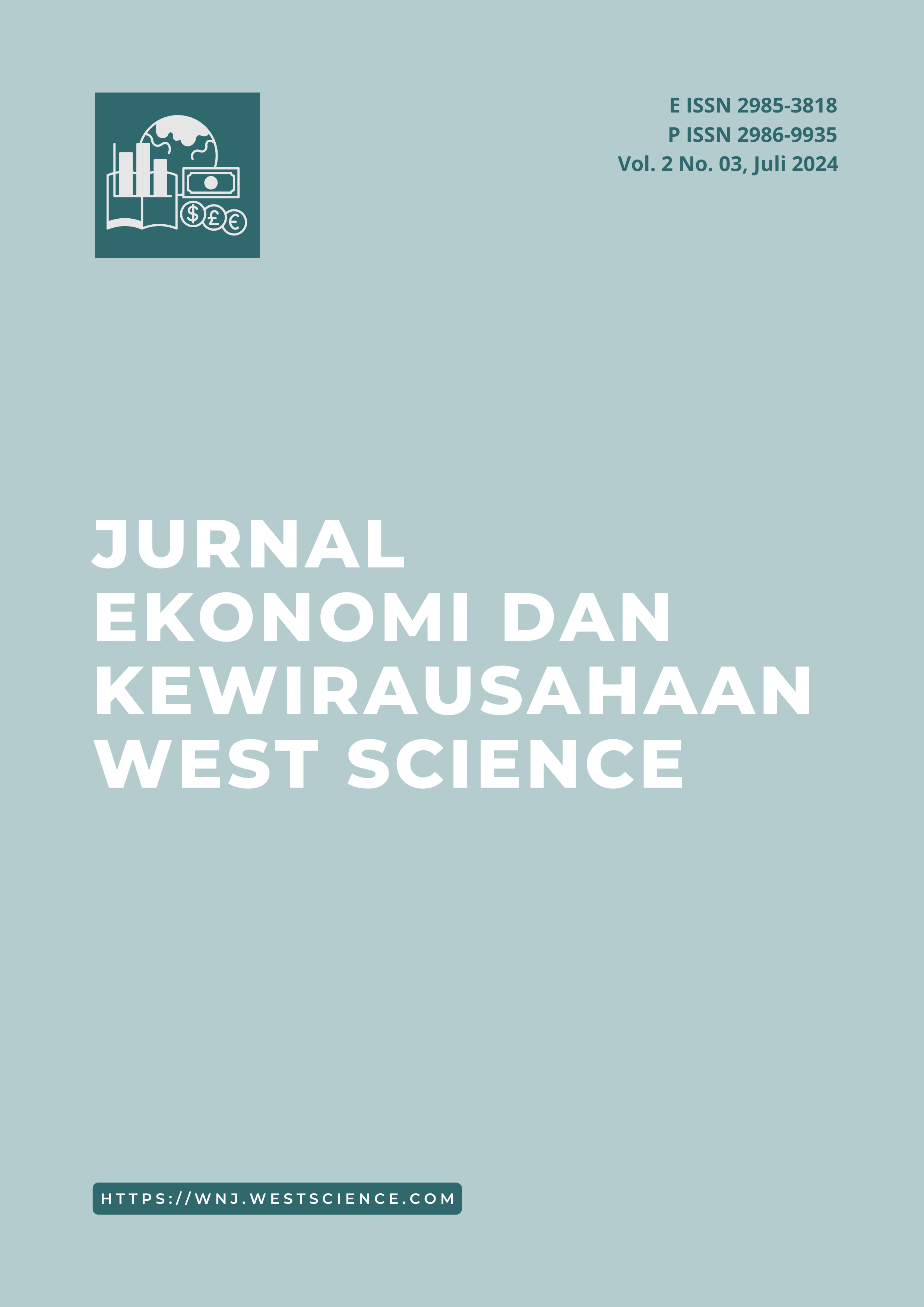Strategi Diferensiasi Produk Mie Gacoan dalam Meningkatkan Keunggulan Kompetitif
DOI:
https://doi.org/10.58812/jekws.v2i03.1428Kata Kunci:
Diferensiasi Produk, Keunggulan Bersaing, Inovasi, BrandingAbstrak
Penelitian ini menguji dampak dari strategi diferensiasi produk, khususnya inovasi, kualitas, branding, dan harga, terhadap keunggulan kompetitif Mie Gacoan. Dengan menggunakan desain penelitian kuantitatif, data dikumpulkan dari 200 responden dengan menggunakan kuesioner terstruktur dengan skala Likert mulai dari 1 sampai 5. Data dianalisis dengan menggunakan Structural Equation Modeling-Partial Least Squares (SEM-PLS 3). Hasil penelitian menunjukkan bahwa keempat dimensi diferensiasi produk - inovasi, kualitas, merek, dan harga - secara positif dan signifikan meningkatkan keunggulan kompetitif Mie Gacoan. Temuan ini menggarisbawahi pentingnya diferensiasi strategis dalam membangun posisi pasar yang kuat dan mencapai keunggulan kompetitif yang berkelanjutan dalam industri mie yang sangat kompetitif. Studi ini memberikan wawasan yang berharga bagi bisnis yang bertujuan untuk meningkatkan posisi pasar mereka melalui strategi diferensiasi yang efektif.
Referensi
Ali, B., & Anwar, K. (2021). Marketing Strategy: Pricing strategies and its influence on consumer purchasing decision. International Journal of Rural Development, Environment and Health Research, 5. https://doi.org/10.22161/ijreh.5.2.4
Bittmann, T., Loy, J., & Anders, S. (2020). Product differentiation and cost pass‐through: industry‐wide versus firm‐specific cost shocks. Australian Journal of Agricultural and Resource Economics, 64(4), 1184–1209.
Brem, A., & Viardot, E. (2015). Adoption of Innovation: Balancing Internal and External Stakeholders in the Marketing of Innovation (Editorial) (pp. 1–10). https://doi.org/10.1007/978-3-319-14523-5_1
Ding, X. (2023). Product Differentiation: Implications for Corporate Finance. Advances in Economics, Management and Political Sciences, 16, 40–45. https://doi.org/10.54254/2754-1169/16/20230968
Fajar, I., & Sugiyanto. (2020). The Influence Of Product Quality, Service Quality, Product Differentiation, Price Perception, And Promotion On Purchasing Decisions Of Gostreet Beauty Products. HUMANIS (Humanities, Management and Science Proceedings), 01(1), 284–289. http://www.openjournal.unpam.ac.id/index.php/SNH
Hanssens, D. M., Michelozzi, L., & Mizik, N. (2023). Brand Value, Marketing Spending, and Brand Royalty Rates. The Cambridge Handbook of Marketing and the Law, Cambridge University Press.
Hasyim, H., Hutahaean, H. B., Situmorang, R., & Devima, S. (2023). Strategi Inovasi Menggunakan Aplikasi Grab Merchant Meteor Aquarium dalam Meningkatkan Daya Saing Wirausaha Pasar Ikan Hias. Business and Investment Review, 1(6), 1–6.
Imran, I. P., Novianti, A., & Hidayat, S. (2024). Analisis Pasar Dan Referensi Konsumen Terhadap Produk Mie Sedaap. Manajemen Kreatif Jurnal, 2(1), 226–231.
Jahan, T., Jahan, A., Pallavi, M., Alekhya, M., & Lakshmi, M. S. (2024). A Study on Importance of Branding and Its Effects on Products in Business. International Research Journal on Advanced Engineering and Management (IRJAEM), 2(04), 656–661.
Kairu, H. N., & Kibe, L. W. (2022). Analysis of Product Differentiation on the Performance of Supermarkets in Nairobi City County, Kenya. Journal of Strategic Management, 6(6 SE-Articles), 97–111. https://doi.org/10.53819/81018102t6044
Kriswanto, M., & Fauzi, N. B. (2023). Inovasi diferensiasi produk dengan metode alih wahana pada materi teks laporan hasil observasi. Diglosia: Jurnal Kajian Bahasa, Sastra, Dan Pengajarannya, 6(1), 43–52.
Li, M., & Tang, Q. (2020). The Influence of Product Quality Differentiation on Telecom Carriers’ Collusion. International Journal of Information Systems in the Service Sector (IJISSS), 12(2), 19–35.
Lu, W. (2023). The Analysis of the Differentiation Strategy as Marketing Strategy of Haidilao. Advances in Economics, Management and Political Sciences, 10, 269–277. https://doi.org/10.54254/2754-1169/10/20230483
Maráková, V., Wolak-Tuzimek, A., Lament, M., & Dzúriková, L. (2023). The competitive advantage of enterprises from the customer perspective.
Maulana, R., & Saputri, M. E. (2024). PENGARUH KUALITAS PELAYANAN, PERSEPSI HARGA DAN STRATEGI PEMASARAN TERHADAP KEPUASAN PELANGGAN PADA MIE GACOAN KARAWANG. Jurnal Lentera Bisnis, 13(1), 304–325.
Murerwa, F. K., Onditi, A. L., & Nyagol, M. (2022). Influence of Product Differentiation Strategy on Performance of Commercial Banks in Lodwar, Kenya. The International Journal of Business & Management, 10(10).
Nachmias, R., Mioduser, D., Cohen, A., Tubin, D., & Forkosh Baruch, A. (2004). Factors Involved in the Implementation of Pedagogical Innovations Using Technology. Education and Information Technologies, 9, 291–308. https://doi.org/10.1023/B:EAIT.0000042045.12692.49
Philipson, S. (2020). Consumers and enterprises as actors on the market. Harvard Deusto Business Research, 9(2), 168–180.
Putra, Y. S. (2018). Analysis of differentiation Strategies to create competitive Advantages in Facing Global Markets. KnE Social Sciences, 254–269.
Rahmawati, T. Y. H., Hermawan, B., Witara, I. M., Yuliyanto, G., & Nugroho, S. P. (2023). Innovation of Red Bean Flour as A Substitution for Wheat Flour in Making Noodle. Gastronary, 2(2), 55–64.
Rinaldi, M., Pertiwi, A. B., & Satyadharma, I. G. N. W. (2023). Perancangan Brand Identity Bandung Communication and Community (Bdgcom_Unity). Jurnal Informatika Ekonomi Bisnis, 1193–1198.
Santy, R. D., & Atika, S. D. (2020). Purchasing decisions in terms of perceived quality and product knowledge. International Conference on Business, Economic, Social Science, and Humanities–Economics, Business and Management Track (ICOBEST-EBM 2019), 94–99.
Schetter, U. (2020). Quality differentiation, comparative advantage, and international specialization across products. CID Research Fellow and Graduate Student Working Paper, 126.
Setiawan, D., & Irawati, Z. (2023). Pengaruh Strategi Pemasaran Digital, Harga dan Kualitas Produk terhadap Kepuasan Pelanggan Mie Gacoan. Jurnal Informatika Ekonomi Bisnis, 657–663.
Singh, P. K. (2022). Competitive Differentiation through Intangibles–A Case Study of Maruti Suzuki Ltd. Research Bulletin, 47(3–4), 49–70.
Sitorus, A. N., Supriandi, S., & Sasmito, P. (2023). The Influence of Promotions, Prices and Location on Customer Loyalty of The Beverage Industry in Bogor City. West Science Journal Economic and Entrepreneurship, 1(05), 84–90.
Stojković, H., Kastratović, E., & Stanković, L. (2022). Innovation as a way of increasing the competitiveness of the economy. Trendovi u Poslovanju, 10(1), 18–25. https://doi.org/10.5937/trendpos2201018s
Zulfikar, I. (2022). Building a strong brand: Marketing strategy to increase brand awareness and consumer loyalty. Neo Journal of Economy and Social Humanities, 1(4), 280–284.
Хоменко, І. О., Бібик, Ю. М., & Сорока, А. В. (2023). PRICING STRATEGY IN THE ROAD INDUSTRY: THEORETICAL FOUNDATIONS AND PRACTICAL ASPECTS. Київський Економічний Науковий Журнал, 3, 150–157.
Unduhan
Diterbitkan
Cara Mengutip
Terbitan
Bagian
Lisensi
Hak Cipta (c) 2024 Dwi Kartika Prananingrum, Hommy Dorthy Ellyany Sinaga, Nunut Asniar, Muhamad Ridhayantho

Artikel ini berlisensiCreative Commons Attribution-ShareAlike 4.0 International License.



















 Instagram
Instagram 